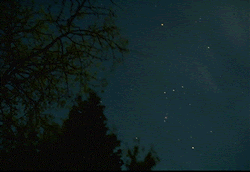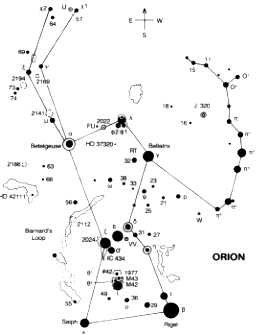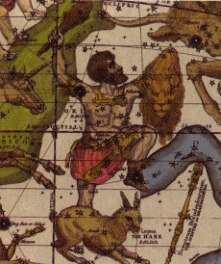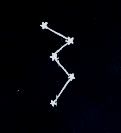 Constellations - star patterns
Constellations - star patterns
 What
Are Constellations?
What
Are Constellations? Looking at the
Constellations
Constellations are
not 'real'
They are imaginary things that poets, farmers, sailors
and astronomers have made up over the past 6,000 years or more to help
us tell which stars are which, nothing more.
On a really dark night,
you can see about 1000 to 1500 stars. Trying to tell which is which
is very difficult. Sorting them out into constellations helps by breaking up the sky into more manageable
bits.
Constellations are used as memory aids by turning stars into dots for a dot-to-dot
picture.
For example, if you spot three bright stars in a row in the
winter evening, you might realize, "Oh! That's part of Orion!" Suddenly,
the rest of the constellation falls into place and you can declare:
"There's Betelgeuse in Orion's left shoulder and Rigel is his foot." And once you recognize Orion, you can remember that Orion's Hunting
Dogs are always nearby. Then you might recognize the two bright stars
in the upper and lower left of the photograph as Procyon in Canis Minor
and Sirius in Canis Major, respectively.
 When
you look in a sky atlas, you might see diagrams like the one on the
right:
When
you look in a sky atlas, you might see diagrams like the one on the
right:
Obviously, this
is very different from the photo above. This type of diagram draws the
stars as different sizes to represent different brightness. In addition,
there is a standard way to connect the stars that allow astronomers
and others who use charts like this to quickly tell what they are looking
at. In almost every star atlas, you will see Orion drawn with these
same lines.
Every star on the
chart is labelled. This type of chart is useful because it accurately
shows the relative positions of the stars in this small region of the
sky. In addition, other things besides stars are also labelled on the
chart. For example, Barnard's Loop on the left and M42 in the bottom
middle are pointed out. Barnard's Loop is a cloud of faintly glowing
gas, which can't be seen without a telescope. M42 is the Great Orion
Nebula and it is the red splotch in Orion's Sword in the photo above.
 Where
did the constellation names come from?
Where
did the constellation names come from?
Why would people want
to remember the stars names? F
armers invented the constellations.
Why did they do that? Was it for some religious purpose?
Yes and no. Around
the world, farmers know that for most crops, you plant in the spring
and harvest in the fall. But in some regions, there is not much differentiation
between the seasons. Since different constellations are visible at different
times of the year, you can use them to tell what month it is. For example,
Scorpius is only visible in the northern hemisphere's evening sky in
the summer. Some historians suspect that many of the myths associated
with the constellations were invented to help the farmers remember them.
When they saw certain constellations, they would know it was time to
begin the planting or the reaping.
This dependence
on the sky became a strong part of many cultures. Perhaps there is something
about the mystery of the night sky that makes people want to tell stories
about the constellations. The picture at the left is an ornate star
chart printed in 1835. Like the others, it shows the great hunter Orion.
In this one, he is holding a lion's head instead of his traditional
bow or shield. He has an eager look in his eye as he stalks Taurus,
the Bull. Behind him, his faithful dog, Canis Major, is chasing Lepus,
the Hare. Compare this picture to the photo near the top of the page.
They are at about the same scale and they show the same stars. The constellations
have changed over time. In our modern world, many of the constellations
have been redefined so now every star in the sky is in exactly one constellation.
In 1929, the International Astronomical Union (IAU) adopted official
constellation boundaries that defined the 88 official constellations
that exist today.

The graphics
above are from "Constellations" by Motz and Nathanson and "Universe"
by Kaufmann

So, constellations
are:
- names for
groups of stars that appear to form shapes in the sky.
- They were
given their names many hundreds of years ago to help us remember
which stars are which.
- We use constellations
to divide up the sky;
- finding one
can help us find another because constellations (being so far
away from us) appear to move so slowly that, in our lifetime,
they will always be found in about the same place
|
The
Big Dipper - part of the constellation of Ursa Major or the
Great Bear)
The best
known group of stars is the Big Dipper. The Big Dipper is a
group of seven bright stars, 3 which form a handle and 4 which
form a bowl.. The Big Dipper is not actually a constellation
but is part of the constellation Ursa Major, or Great Bear.
|
Little
Dipper - part of the constellation of Ursa Minor or the Little
Bear
The Little
Dipper is a mirrored and smaller version of the Big Dipper.
It can be found by looking directly up from the two outermost
stars which form the bowl on the Big Dipper. These two stars
point us to Polaris, the Pole Star (indicating the North Pole),
which is at the end of the Little Dipper's handle.
|
|
|
|
 |
Orion
Another
well known constellation is Orion. Orion was an ancient Greek
hunter and warrior and the constellation resembles this figure,
with a club and a shield, and a sword dangling from his belt.
The belt is usually the easiest part of Orion to spot, with
three bright stars in a row. Can you find his belt in the picture
below? Orion has more bright stars than any other constellation;
the two brightest are Betelgeuse (shoulder) and Rigel (foot).
|
|
Cassiopeia
Cassiopeia
is found next to the Big Dipper and Orion. Its shape is easy
to remember, a neat W, or M, formed by 5 bright stars. Cassiopeia
is the mythological Queen of Ethiopia.
|

|
|
|
|
The
Pleiades Seven Sisters)
|
|
The
Seven Sisters were said to be the daughters of Atlas and the
objects of Orion's affection. As the name Seven Sisters implies,
there are seven stars in this constellation but most people
can only see six. The Pleiades is located between the constellations
of Taurus and Perseus.
|
|
Sky Chart
This
chart shows some of the constellations mentioned above. In
the middle you can see the Big Dipper, using this we can find
several other constellations around it. As mentioned above,
the side of the Big Dipper's bowl points to Polaris in the
Little Dipper. The bottom of the bowl points to the constellation
Gemini, the left side of the bowl to the constellation, Leo,
and the handle to Bootes. Cassiopeia can also be seen in the
top left corner. To find out more about any of the constellations
mentioned here (and those which aren't) visit some of the
sites listed below.
|
 |

Links to other
constellation web sites:
The
Constellations and their Stars
I had very little authorship of this page. The
information and illustrations of this page were taken from http://www.kn.pacbell.com/wired/fil/pages/samstarsanda.html
on 26/11/00 . This
site has sadly now ceased to operate and I could not contact the author
for permission to post this excellent information..
LOJ
November 2000 Amended March 2003





![]()



 When
you look in a sky atlas, you might see diagrams like the one on the
right:
When
you look in a sky atlas, you might see diagrams like the one on the
right:
 Where
did the constellation names come from?
Where
did the constellation names come from?



